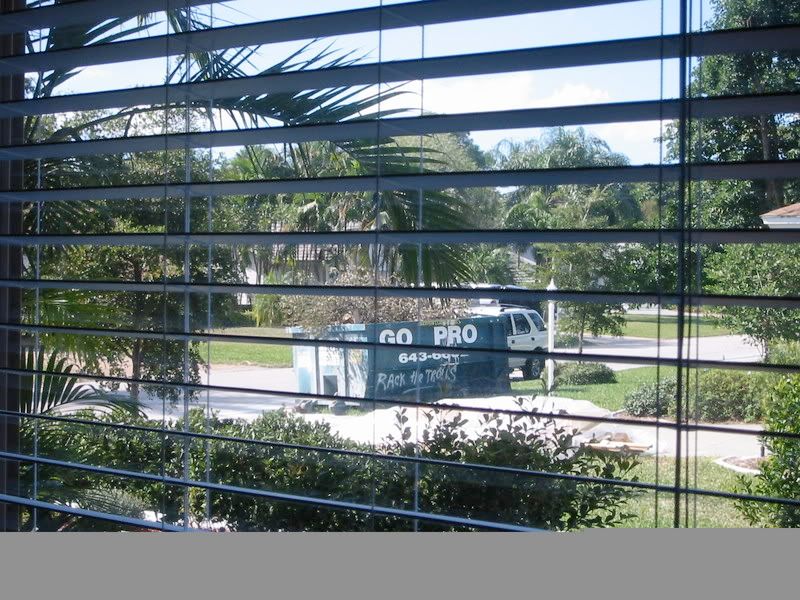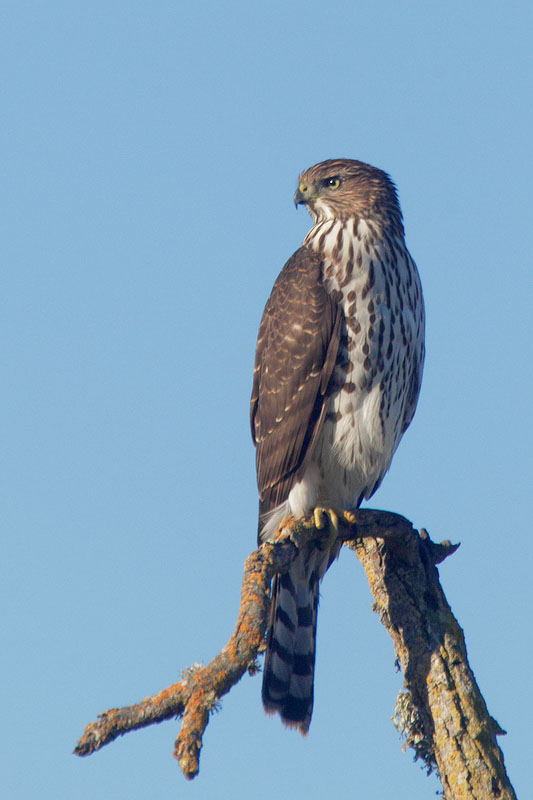View from my office window a few minutes ago
Posted: Tue Jun 19, 2012 6:52 pm
This guy seemed to like posing.






And any of your posts are ???Atomic Punk wrote: After all, this is a smack board and this post by Mikey isn't entertaining nor funnay.
I'll side with Roach here you idiot. Derron, me picking on you is like picking on the dumb, deaf, and blind. Please continue on.Derron wrote:That is a red tail hawk.

Given the subject line, I was expecting a different type of hooters.Cuda wrote:it's an owl.
I doubt it. Especially not sitting in the middle of all that foliage. They prefer open spaces and that guy there doesn't look big enough for a red tail.Mikey wrote:Red tail hawk.

Yep. Pretty sure you're right there.mvscal wrote:I doubt it. Especially not sitting in the middle of all that foliage. They prefer open spaces and that guy there doesn't look big enough for a red tail.Mikey wrote:Red tail hawk.
I would guess Cooper's hawk. They look almost exactly like Sharp shinned hawks but are much more common in suburbia.
I believe I'll wait for Dinsdale to show up with the correct answer.Mikey wrote:Yep. Pretty sure you're right there.mvscal wrote:I doubt it. Especially not sitting in the middle of all that foliage. They prefer open spaces and that guy there doesn't look big enough for a red tail.Mikey wrote:Red tail hawk.
I would guess Cooper's hawk. They look almost exactly like Sharp shinned hawks but are much more common in suburbia.

Now imagine it's dusk, in slo-mo I want you to picture a lumbering shutyomouth gliding towards the door of his local Wendy's. 20 ft away and through two sets of plate glass his eyes are already locked in on his prey. It takes his brain milliseconds to determine that there are eight jr. bacon cheeseburgers already cooked, wrapped, and waiting under the heat lamps. He hasn't even grasped the door handle yet.mvscal wrote:...and, to this day, still probably the most elegant way to hunt for your dinner.
we've got a lot of peregrine falcons out here and their only advantage is that they're really fast....but they miss more often than not....mvscal wrote: Raptors are essentially brainless but perfectly adapted guided missiles.
DC Smackmaster wrote:Now imagine it's dusk, in slo-mo I want you to picture a lumbering shutyomouth gliding towards the door of his local Wendy's. 20 ft away and through two sets of plate glass his eyes are already locked in on his prey. It takes his brain milliseconds to determine that there are eight jr. bacon cheeseburgers already cooked, wrapped, and waiting under the heat lamps. He hasn't even grasped the door handle yet.
R-Jack wrote:DC Smackmaster wrote:Now imagine it's dusk, in slo-mo I want you to picture a lumbering shutyomouth gliding towards the door of his local Wendy's. 20 ft away and through two sets of plate glass his eyes are already locked in on his prey. It takes his brain milliseconds to determine that there are eight jr. bacon cheeseburgers already cooked, wrapped, and waiting under the heat lamps. He hasn't even grasped the door handle yet.
in the voice of one of those Wild Kingdom queers...
As the shutyomouth, focused on grease consumption, lumbers graciously towards door handle, the same cerebral percision that identified his prey also spots his mortal enemy. The salad. The Wendy's is festered with them. Rather than tempt fate, the cunning shutyomouth decides to struggle to breathe for another day and lies in wait for Wing Stops and Whitecastle's.

It’s one of those Willamette Valley early summer days: The sky is too blue to be true, and the inconsequential clouds on the horizon look like a pattern of brushstrokes. Mount Hood is a travel-poster backdrop in the east, and the breeze keeps you from sweating.
For Chaco, a Saker falcon, it’s a good day to ride the thermals.
He circles upward until he’s a tiny black dot more than a thousand feet above the ground. Blink and he’s gone. Moments later, he’s dive-bombing potential prey, then disappearing again on a whim.
Back on Earth, 70 acres of ripening blueberries stand protected by nature’s instinctual reaction to that falcon. The flocks of starlings that eat away profits on so many berry farms and vineyards won’t land here. For them, that circling speck in the sky is a life-threatening presence that keeps them from sticking around.
This is what one expects in the natural order of things.
So uninformed observers enjoying an eyeful of the falcon’s flight might be surprised that Chaco’s wind-surfing is only an imitation of nature.
Instead, it’s the careful orchestration, through rigorous training, of a captive bird of prey. The goal: to protect fruit as it sugars up in the sun before the imminent harvest.
The conductor of this operation is Getty Pollard, whose company, B-1RD LLC, provides bird abatement on farms. Chaco’s riding of the thermals — the quintessential image of nature’s freedom — is the basis of the program.
At the end of the day, Chaco doesn’t bed down under the stars with his mate and a couple of chicks in a high conifer perch. Rather, he takes his rest in a trailer with three of his feathered co-workers.
Whether he minds is anyone’s guess. As the saying goes, you can’t miss what you never had.
They get movie-star trailers
As Pollard tells it, his birds are healthier than wild ones. At 4, Chaco has deep brown eyes that are clear and bright. His beak and talons are not battered, dull or flaking. His feathers are clean and intact. And Chaco himself is alert, even personable.
Pollard keeps the trailer off-limits, he says, to provide a sanctuary where the birds can relax.
“We don’t want our birds to be any different than wild birds,” says Pollard, who tries to replicate a wild falcon’s daily feeding, hunting and flying habits.
Further, he explains, limiting the falcons’ interactions with other humans helps keep them wild, and therefore safe.
Another component to this philosophy is the hand-sewn leather hood that Pollard puts on Chaco when he might be stressed by environmental wild cards such as the unpredictable movements of strangers. Pollard likens the hood to blinders on a horse.
“What they can’t see they can’t fear,” Pollard explains.
The hood sports a tassel on top. Cinched around the back of his neck, it covers the bird’s eyes and is shaped around his curved beak. The hooded Chaco looks at once like a blinded medieval warrior and a poster child of the animal rights movement.
But Chaco hardly seems tortured. Perched atop Pollard’s leather-gloved left hand, Chaco preens his feathers, varying shades of coffee and cream.
“When a bird starts taking care of himself, you know he’s content,” Pollard says. “You know he’s happy.”
Starlings took nearly 5%
Based in Lostine, in Oregon’s northeastern corner, B-1RD is hired by farms and vineyards on a seasonal contract for “falcon crop protection.”
The company currently has 18 birds of various ages that winter in Lostine. During the growing season, Pollard and other “falcon specialists” take small groups of the birds to farms.
This blueberry season, Pollard, along with two specialists, are working four falcons at Gingerich Farms, south of Canby.
The farm is marketing its sustainable growing practices, boasting riverbank restoration and claiming 10 acres of blueberries that are going through the three-year process to be certified organic. The farm has been a certified organic processor since 2003.
Bird management has been an ongoing issue on the farm. Craig Messmer, Gingerich’s senior sales manager, estimates that aggressive flocks of starlings were damaging about 1,000 pounds per acre — an average acre yields about 22,000 pounds of blueberries.
“It was out of control,” he says.
Resisting the option of netting the acreage, because of the impracticability as well as the environmental impact (the netting itself may be generated from petroleum products, and securing it over 70 acres would require a hefty amount of materials in posts and fasteners), the farm has instead been installing bird boxes to encourage owls and other raptors. Staff have exhausted options such as gunfire, cannons and balloons, all of which starlings learn to ignore.
Pollard explains that the threat of the falcons remains constant because they don’t kill. He ensures this by occasionally corralling them back from their high-altitude cruising for a snack of raw quail. Frozen whole and thawed out the night before, the quail is the only item on the falcon’s menu.
Pollard, 32, says he’s been flying birds since he was 14 and is licensed in the sport of falconry, which dates back thousands of years.
Pollard bases the training of his flying scarecrows on food and on the falcons’ hunting instincts, which he asserts remain fully intact despite their captive lives.
Bob Sallinger, conservation director at the Audubon Society of Portland, agrees. “That’s what they were put on this Earth to do,” he says.
Sallinger also asserts that given the alternatives — including poisoning bird pests — this is definitely a more sustainable option for farmers.
“A lot of birds are killed in this country to protect agriculture,” says Sallinger, who believes that Pollard’s method is “an ecologically responsible way to address these kinds of depredation concerns.”
Birds keep own schedule
Only one falcon patrols at a time. And when he dips into a flock of starlings, scattering them up and onward, Pollard calls him back for a reward.
Pollard’s daily routine consists of riding the fields on an ATV, keeping track of his pseudo-hunter. He gets the falcon’s attention in a number of ways, including blowing the whistle that hangs around his neck and waving his arms or a leather lure that looks like a small bird.
But today, the conditions are too perfect to come down just yet. Chaco stays out of sight for close to an hour, and Pollard’s only connection with him is the beep, beep, beep of the receiver that picks up the radio transmitter around Chaco’s ankle.
Pollard’s not worried, though.
“My best birds fly like this,” he says in between breaths on the whistle and rounds in the ATV. “Falcons are not robots.”
After an hour and 45 minutes, Chaco returns. In the midday sun, he enjoys bloody quail innards and a spritzing from a water bottle. Although there is no scratching behind the ears or rubbing of the belly, Pollard is attentive to the Chaco’s needs, wanting to get him out of the sun.
Pollard says when you make a living with an animal, you take it seriously.
“I make a living with this bird’s ability,” he says. “If they don’t like me, they can go anytime.”
that's the first sensible thing you've said in the last dozen yearsGoober McTuber wrote:I believe I'll wait for Dinsdale to show up with the correct answer.
How many nutsacks can you cling to at one time?Cuda wrote:that's the first sensible thing you've said in the last dozen yearsGoober McTuber wrote:I believe I'll wait for Dinsdale to show up with the correct answer.